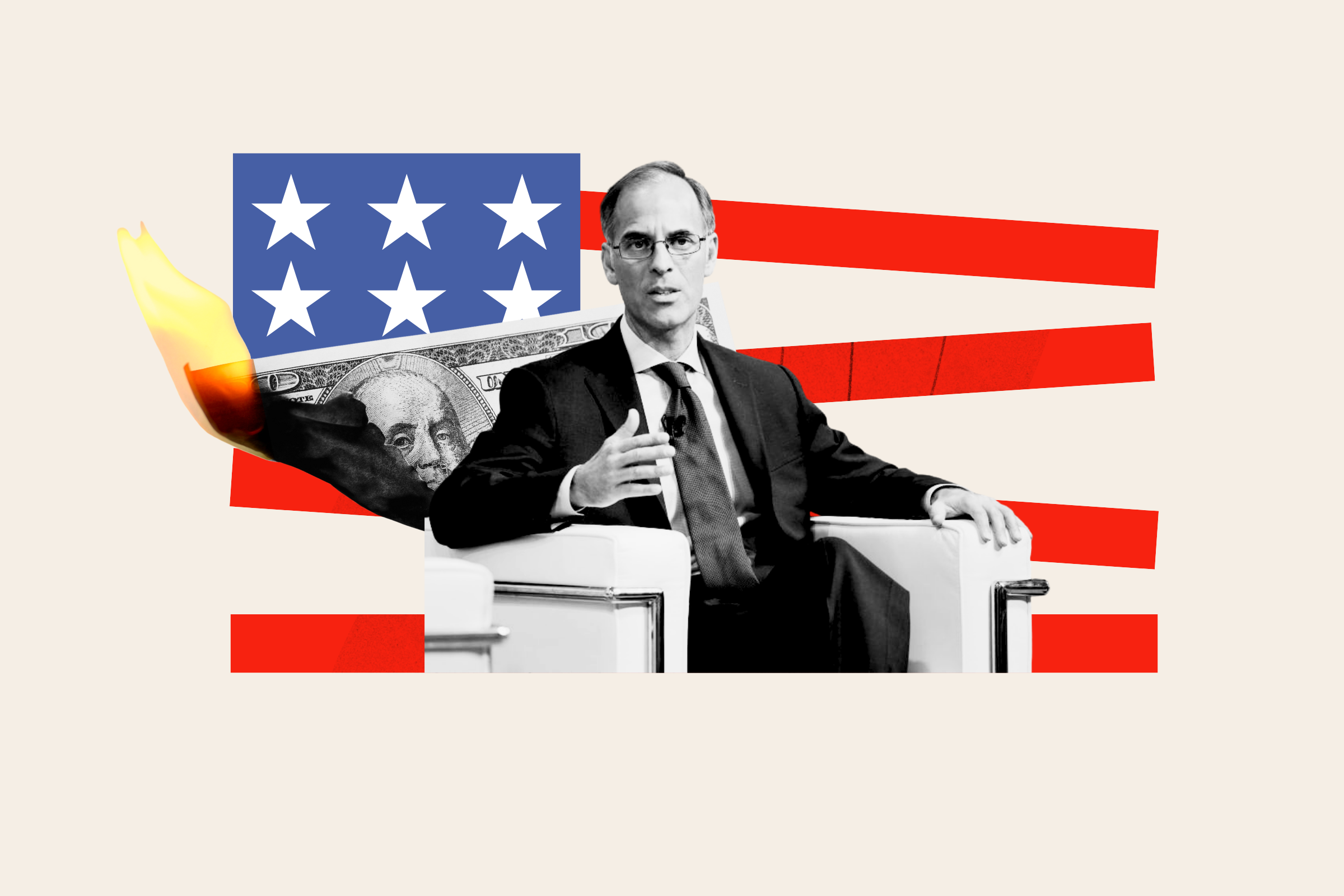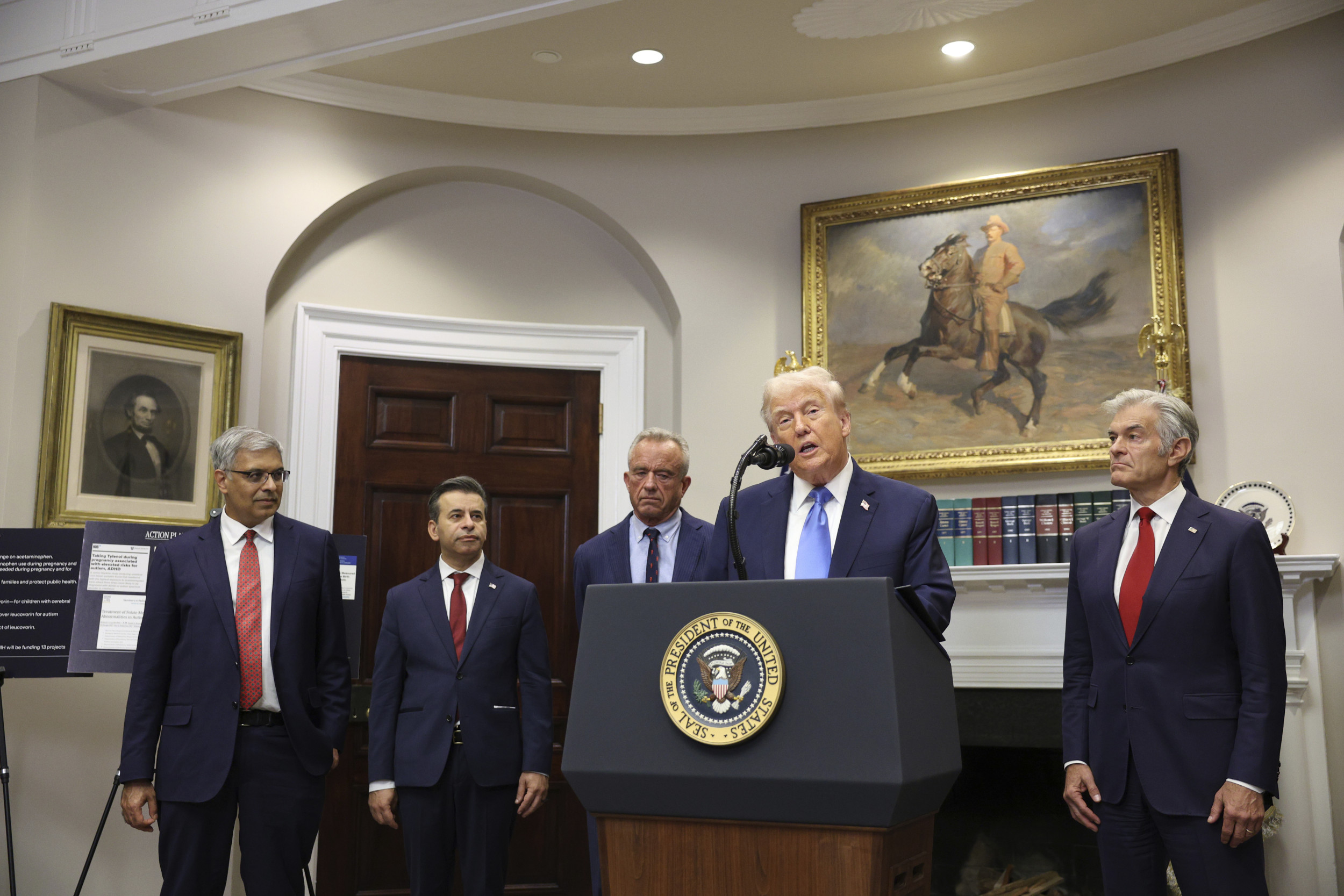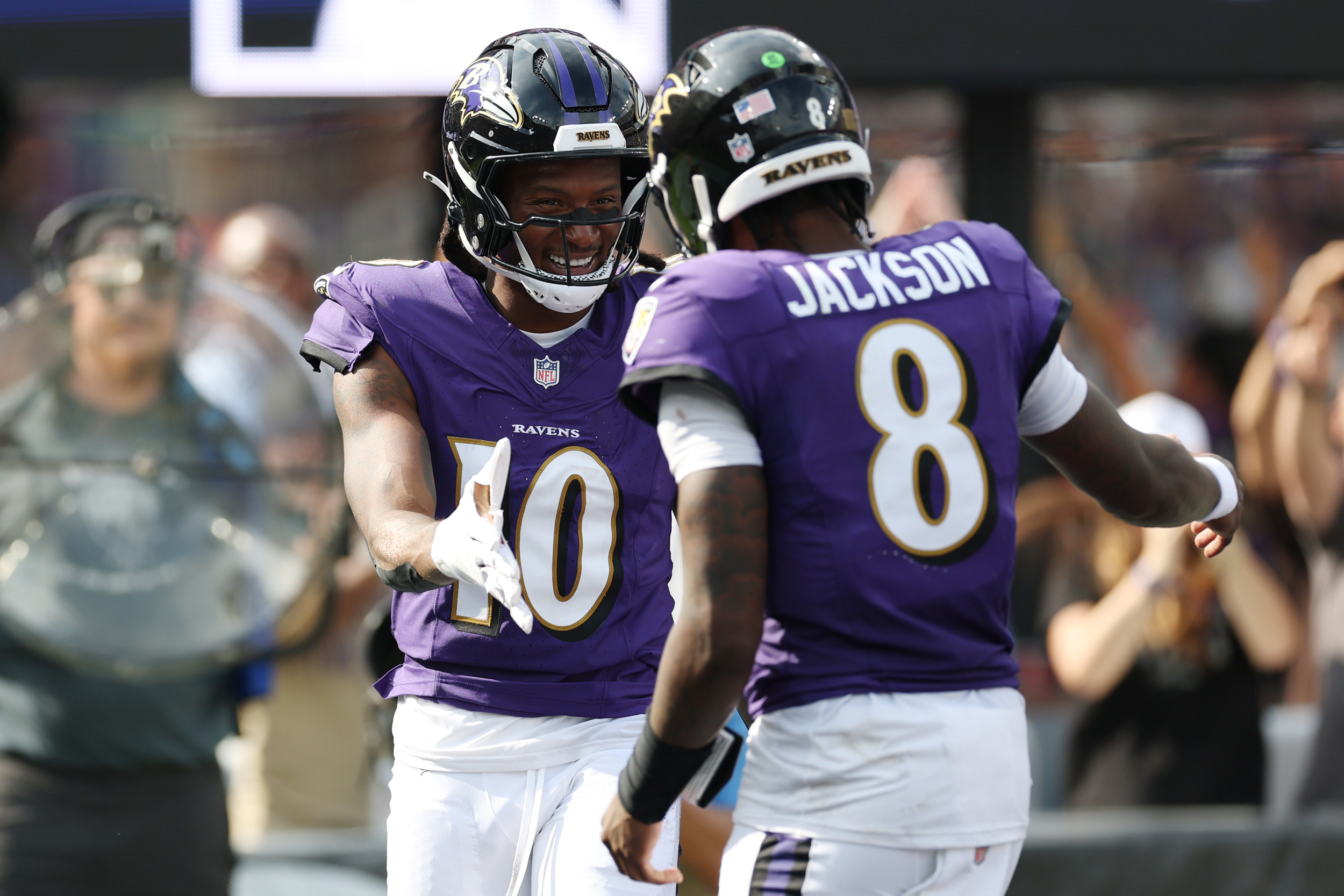
President Donald Trump has rarely passed up the opportunity to tell Americans that the U.S. economy, with his hand at the wheel, is roaring.
His administration has held up GDP growth rates, high levels of foreign investment and relatively benign inflation readings as evidence that tariffs have been a resounding success, and that it is only skeptical policymakers within the federal government holding back an otherwise unrivaled boom.
But to Mark Zandi, chief economist at Moody’s Analytics, the warning signs—or “red indicators”—are showing up in every corner, from housing to employment to consumer prices. In an interview with Newsweek, Zandi said that his monthslong fears of a major economic downturn may soon come to a head, and that the U.S. economy could slip into a recession by the end of 2025.
“I don’t think the economy is in a recession, at least not at this point,” he said, “but it feels like it’s on the brink, it’s on the precipice of this recession.”
Zandi was one of the first economists to forecast the 2008 financial crisis, and has issued numerous warnings about similar downturn over the past couple of months as the implications of the administration’s policies on trade and federal job cuts came to light.
Job Growth At ‘Virtual Standstill’
At the top of his “long list of indicators to be concerned about” is jobs. Jobs growth—as revealed by recent payrolls reports—has slowed to what Zandi describes as a “virtual standstill.” However, while businesses remain reluctant to add to their payrolls, they have not begun laying workers off en masse, which Zandi considers one of the key factors preventing the economy from tipping into a full-blown downturn.
“That’s the firewall between recession and no recession, is the low layoffs,” he said. “So we’re not in recession, but I’d say the indicator that’s flashing reddest is jobs.”
“As soon as you see negative employment—payroll employment decline in a month—that’s when alarm bells should start going off,” he added. “And I would anticipate that that’s going to happen, and that’s going happen soon.”
As data on employment continues to trickle in—with eyes on Friday’s nonfarm payrolls report and any further revisions this may contain—Zandi said his other central priority will be tracking how tariffs have, any may continue to, impact the American consumer who in his words, “drives the economic train.”

Newsweek Illustration/Getty Images/Canva
Trump’s tariffs have not hit the American wallet as hard or as fast as Zandi initially predicted. Companies have likely held off on hikes as the eventual tariff rates remained in flux, he told Newsweek, and due to fears of “getting caught up in the political buzzsaw if they raise prices in a public way.” But this reprieve may be short-lived, and Zandi expects the annual inflation rate, currently 2.7 percent, to climb past three and close in on four by this time next year.
“Prices are already rising, you can see it in the data, but it’s going to rise to a degree that it will be impossible for people to ignore,” Zandi said. “They’ll see it clearly in the things that they’re buying on an everyday basis.”
Rising prices paired with a surge in layoffs, he warns, could trigger a “self-reinforcing vicious cycle”: cash-strapped consumers cut their spending, margin-squeezed businesses respond with layoffs, a layoff-swept economy further tightens its purse strings, and so and so on until a recession seems all-but inevitable.
When approached for comment on Zandi’s concerns, the White House told Newsweek that Americans had already heard “these same doom-and-gloom predictions during President Trump’s first term—when his America First agenda ushered in historic job, wage, investment, and economic growth.”
All Eyes on New York and California
Zandi recently estimated that states representing around one-third of the U.S. economy were approaching or had already entered a recession, based on “various coincident measures of economic activity” including employment, industrial production and housing starts. The states Zandi described as “treading water” include California and New York, heavyweights who together account for over a fifth of the nation’s GDP.
Everything might hinge on these bellwethers of the wider economy, Zandi believes.
“I think what happens with California and New York may decide what happens to the nation,” he said. “I mean, if California and New York weaken and start to contract, the national economy is going to go into recession.”
However, if they prove able to “hold their own,” Zandi said “the economy is going to be fine and get through without recession.”
“So I’d say all eyes on California and New York at this point.”
Some other economic voices, while equally pessimistic about America’s economic health and trajectory, have focused less on contemporary shocks and more on the systemic stressors, such as a contracting money supply and a mounting national debt. While Zandi believes these analyses hold merit, he nevertheless views the economy as fundamentally sound.
“There’s a lot also structurally that’s right about the U.S. economy,” he said, pointing to the boom in artificial intelligence and technology more broadly, which he described as having “real and significant, very positive economic consequences.”
“I do think if we can get beyond the fallout from the policies that have been put in place, those positive structural forces will ultimately win the day,” he said.
Recession is far from a done deal—Moody’s machine-learning model recently placed the probability at 49 percent—but despite near-even odds, Zandi sees the dangers closing in fast and the dashboard blinking red.
Read Newsweek’s full interview with Mark Zandi below:
Q: Of all the economic indicators that you’re assessing daily—be they employment, the housing market, GDP—which would you say currently are flashing red or giving the greatest cause for concern?
Zandi: Well, there’s a lot of red indicators. I think that the long list—at the top would be jobs. Job growth has slowed sharply this year and in the last few months has come to a virtual standstill. And that job growth that we are getting is very narrowly concentrated in a few industries: Health care, educational services, state and local government.
The weakening in job growth goes to what feels like an economy-wide hiring freeze. Businesses are just very reluctant to add to their payrolls. They’re not laying off, and that’s great. That’s the firewall between recession and no recession, is the low layoffs.
So we’re not in recession, but I’d say the indicator that’s flashing reddest is jobs. But a lot of other indicators are also signaling the economy is struggling. GDP growth in the first half of the year was just over 1 percent annualized. That’s…punk kind of growth.
The real consumer spending all in has gone nowhere so far this year. Manufacturing is contracting. Construction, despite the boom in data center activity, is contracting. Transportation distribution is in recession. You know, so a long list of indicators to be concerned about.
Again, I don’t think the economy is in a recession, at least not at this point, but it feels like it’s on the brink, it’s on the precipice of a recession.
Q: Now of all of these, just as tariffs have started to take hold, which would you be keeping the closest eye on?
Zandi: I mean, obviously, first order is prices, inflation. Are the tariffs translating through to higher prices for goods and higher inflation as we anticipate?
And so far the pass through has been slower than I would have thought. But I think that relates to the fact that the tariffs are up and down and all around and businesses just don’t know where they’re going to land and don’t want to raise prices until they have a fix on where those tariffs are going to ultimately settle. And I do think a lot of bigger businesses are nervous about getting caught up in the political buzzsaw if they raise prices in a public way. So it’s taking a bit longer than I would have thought, a month or two longer, but I think we will see prices continue to rise.
And that’s the first thing we need to see to happen. And then what impact does this have on consumers? The American consumer drives the economic train, and as prices rise and that weighs on people’s purchasing power, their real income. Will they pull back on their spending or hold the line, or will they be willing to drop their saving rates sufficiently to maintain their current rates of spending? I’d watch that very carefully.
And then finally, layoffs…If prices rise, consumers grow more cautious. Will businesses respond to that by starting to lay off workers? If they don’t, then I think the economy can continue to kind of muddle its way through here, get to the other side of the tariff effects and the immigration effects. But if businesses start to increase layoffs, then that’ll set off a kind of self-reinforcing vicious cycle—layoffs, less spending, less spending, more layoffs.
So it’s prices, second is spending, third are layoffs. So those are the indicators I’d be watching most carefully.
Q: You said it’s taken a bit longer for the price impacts of tariffs to drip into consumer prices. When do you think these will start to show up in a way that everyday consumers are able to say, “Hey, here it is,” or companies are forced to raise their prices to maintain their margins?
Zandi: Now. I think in the second half of this year, it’s going to become obvious that the tariffs are resulting in higher prices for a broad array of goods, and I think the American people will see that.
Inflation, which is now just under 3 percent, at least as measured by the consumer expenditure, will rise consistently above 3 percent and start closing in on 4 by this time next year, I think that’ll be enough to get people’s notice and their level of angst will start to rise.
So I think we’re now at that point where we’re going to start. Prices are already rising, you can see it in the data, but it’s going to rise to a degree that it will be impossible for people to ignore. They’ll see it clearly in the things that they’re buying on an everyday basis.
Q: I know Moody’s own algorithm has placed this at about 50-50 for the past couple of weeks and months, slightly higher than in March. If you were to make a guess, when do you think all this will come to a head and people will at least be able to declare that the U.S. economy is in recession.
Zandi: Well, if we actually go in, it’s going to be towards the end of this year, beginning of next. That’s when the economy is going to be at its weakest, when the price increases resulting from the tariffs have hit purchasing power the hardest, and when we might start to see some layoffs. Also the highly restrictive immigration policy will continue to bite.
Labor force growth has come to a standstill, and that’s going to mean fewer jobs, if any jobs. We may even start to [see] some job loss, and that’ll become clearer towards the end of the year into next.
Historically, recessions begin and end with payroll employment, with jobs. When employment goes negative in a given month—and that’s the start of a job loss on a consistent basis—that’s start of recession. That’s when the National Bureau of Economic Research (NBER), the group of academics that date business cycles here in the U.S., will date the start of a recession.
So as soon as you see negative employment—payroll employment decline in a month—that’s when alarm bells should start going off. And I would anticipate that that’s going to happen and that’s going happen soon. I mean, with the September 5th, next week, September 5th is the release of the August employment data, presumably, unless the Trump administration decides not to.
But if…they release, that would be a really important report. It’s very possible, particularly with revisions, that we could get some negative numbers, and that would signal that recession has now become much more likely—and that will be the start of the recession.
But in my kind of baseline, most likely view of the world, and this is consistent with the recession indicator, while we get close to recession, we don’t actually go in. We’re able to kind of skirt and avoid one, but it’ll be very close and obviously when the economy is struggling as it is, it’s vulnerable to anything else that can go wrong. Impossible to anticipate what that could be, but obviously…there’s many things that could not stick to script, and it wouldn’t take a whole lot to push the economy into recession, given its vulnerable state.
Q: You mentioned the NBER, which I know doesn’t use this definition, but the shorthand rule for a recession is two quarters of GDP contraction. How do you square this with the idea that we’re on the precipice of a recession, or do you think the GDP contraction rule is a bit defunct in this case?
Zandi: I think it’s kind of a rule of thumb. I don’t think that’s hard and fast. I think the NBER defines a recession as a broad-, and I’m paraphrasing, broad-based persistent decline in economic activity.
So I think you could have a recession based on that definition, which I think is the appropriate definition, even if you don’t have two quarters of consecutive declines in GDP. I mean, if we only had one, like the first quarter, we had a decline, and that’s the end of the story, then it’s unlikely we’re gonna suffer a recession.
If, however, and it feels at the moment, like Q3, the current quarter, we’re going to get a small positive increase, maybe one-and-a-half, 2 percent.
But if we’re to have a recession, I think it’s going to start in the second half of the year and really become evident in the fourth quarter of the year. First quarter of next that’s when you would expect to see, again, if we’re gonna have a recession, when you’d actually see more GDP declines. And then at that point, you know, it’s very possible they’re consecutive—one in the fourth quarter and another one in the first quarter next year.
Q: So could you say that—I know the last, the second quarter GDP estimates, they were sort of pumped up by surging imports—I mean could you see that with the economy of this recession in particular, tariffs are kind of highlighting the flaws in this two-quarters heuristic?
Zandi: Well I think that heuristic has been, you know, we’ve recognized the flaws in that heuristic for a long time.
I mean, if you go back, there’s a number of recessions where—like the 2000, 2000 kind of that period, 2000, there was a 2001 recession—I don’t believe there was two consecutive quarters of decline in GDP, and that was a recession. Not consecutively. There were two quarters of decline, I believe, but not consecutively. So I think that’s always just been kind of a rule of thumb, as you say, a heuristic.
I think a much better indicator, tell, of recession is jobs and payroll employment. And if that is negative in a consistent way, not for just one month, but it’s consistent, It’s falling for four, five, six months. That’s very, that’s I think a much better kind of rule of thumb for recession than two consecutive quarters of negative GDP. It’s helpful and consistent with, historically, when we date recessions, but I don’t know that…I think that we’ve always recognized that as kind of an imprecise and flawed rule of thumb.
It is helpful, but not the arbiter of recession, nor should it be.
Q: So when the administration holds up these numbers and says the economy is booming, you think that’s maybe taking it a bit far?
Zandi: Well, I won’t comment on what [they say], but what I know is the economy is struggling.
The first quarter was negative. The second quarter was positive. The net of that is 1, one-and-a-half, percent growth. That’s, that’s not booming. That’s half the growth we got in 2024. And it’s below historically what we would consider the economy’s potential growth, which is around 2. So that’s far from booming.
Q: You recently assessed that states representing around a third of U.S. GDP were in or nearing recession. What could take place over the next couple of weeks and months that would push this figure higher to say half, 60 percent, etc?
Zandi: The interesting thing is if you look at the states that are kind of in the middle tier, the treading water, kind of moving sideways, the two biggest states are California and New York. And I think what happens with California and New York may decide what happens to the nation.
I mean, if California and New York weaken and start to contract, the national economy is going to go into recession. And if those economies hold their own or start to accelerate or reaccelerate, the economy is going to be fine and get through without recession.
So I think if I were looking at the list of 50 states and the District of Columbia, I’d be focused on those two states. They’re large. I think together they count for over a fifth of GDP, national GDP. They are treading water. They can go either way. And I think depending on which direction they go could determine whether we fall into recession or not.
I mean, California is getting it’s clearly a boost from the AI boom and technology boom. And that’s helping. And New York is, you know, getting some help from professional and financial services and health care. But those…industries, you know, they need to continue to provide that tailwind for those states to avoid a downturn and for the nation to avoid the downturn.
So I’d say all eyes on California and New York at this point.
Q: Regarding recession risks for the nation as a whole. To what extent do you see these as directly a product of the current administration’s policies?
Zandi: I’m sorry, the weakness in the economy?
Q: As directly a product of the administration’s economic policies?
Zandi: Yeah, I mean, I think what ails the economy is clear. It’s the tariffs and it’s the restrictive immigration policy. Those two things are doing real damage to the economy.
I mean, most of the damage so far is just the uncertainty that they’ve created and which has caused businesses, the Federal Reserve, to kind of sit on their hands. And one reason why we have this hiring freeze is just businesses don’t know how these policies are going to play out and what it means for them.
So it’s not that like they’re cutting, they’re not laying off, so it’s not a recession, but it’s the reason why they have paused. And now we’re going to see the real consequences of these policies in the form of higher prices, reduced purchasing power, less labor force.
All those headwinds are starting to gather. And, you know, depending on how hard those headwinds blow will determine whether we go into recession or not. But they go directly—connect the dots from all this right back to policy. It’s the policies that are behind the weakening in the economy.
Q: Some other economists like Steve Hanke and Ray Dalio, when they discuss contemporary weaknesses with the U.S. economy, they attribute these to more long-term things like a contraction in the money supply or the levels of national debt. What do you make of the idea that the U.S. Economy is structurally unsound and that contemporary shocks might just be pushing it over the edge?
Zandi: They’ve got a point. I mean the economy, the U.S. economy has its structural problems. I mean, obviously the deficit, the large deficits and the high and rising debt load are a long-term corrosive on the economy, on interest rates in the economy. So we definitely have our problems.
But I think, you know, there’s a lot also structurally that’s right about the U.S. economy. I mean, that was clear if you go back in 2024 when, before the tariffs and the immigration policy, the economy was growing very rapidly, doing quite well. And of course the poster child for kind of what’s structurally going right is the boom in AI and technology more broadly. And that’s real and having real and significant, very positive economic consequences that’s showing up in lots of different places.
Yeah, there are structural problems and issues, no doubt, but the U.S. economy has some significant long-term strengths, and I do think if we can get beyond the fallout from the policies that have been put in place, those positive structural forces will ultimately win the day.
Maybe ultimately we’re going to have to address our fiscal situation…I don’t think that’s next month or maybe even next year, but clearly we’re going to change that trajectory. So I don’t want to dismiss that as a problem. I just think we’ve also got our strengths as well.
And fundamentally, the economy is still sound and that would shine through if we can just get to the other side of the fallout from the tariffs and the immigration policies.
Q: You said elsewhere, I believe it was an interview with Chuck Todd…that it feels like we’re being pushed into a recession. I mean, is this unprecedented? Or in other words, can you think of a time when politicians have directly and perhaps knowingly enacted policies that push the country into a recession?
Zandi: Policy errors are often an element of all recessions. Often, it’s the Federal Reserve who kind of missteps, doesn’t get it quite right. And that’s not to place blame. It’s just because it’s so hard to get it right. But the Fed just kind of misjudges what’s going on and pushes too hard on interest rates and pushes the economy in.
So historically, policy has always played a role. Even in the financial crisis, one could argue that there were policy errors around the resolution of failing financial institutions that exacerbated and the run on the banking system and the broader financial system that ultimately led to the GFC [global financial crisis]. So, in that respect, it’s not unprecedented. I mean, policy always plays a role; or generally always plays role.
But, you know, the policies put in place here stand out in that they were by design, you know, they were chosen policies. Historically, previously, those policies were in reaction to, they were in response to, events that were caused by different other factors.
And this case, it’s the policies themselves that are causing the problem. So in that sense, it is, as far as I can tell, unprecedented in that regard.
But policy always plays a role. It’s just playing a role that’s different this go around.
Q: Do you think the administration is aware of this and these risks, but thinks it’s prioritizing a larger goal, or that what it believes what it’s doing is sound economic policy?
Zandi: Hard to know. I mean, I’ve heard a lot of different explanations, you know, from different policymakers with regard to what the motivations are for the policies. And to some degree, in the case of immigration, that’s just a reaction to how—let me, let me just state up front: The tariffs and the immigration policy should not be a surprise, right? I mean, President Trump in his campaign made it very clear that this is the policies he was gonna pursue. So it’s not like this came out of the sky, this is policies that were being discussed long before the election and he won the election.
So it’s not something foisted on the American economy. This is policies that were articulated and the president was duly elected to pursue them and he’s pursuing them aggressively. So, I think that’s very important to recognize.
And the motivations that I’ve heard coming from the president and the administration are several-fold. There are lots of different motivations, generating revenue—the tariff revenue is quite significant. It’s going to be $2 trillion over 10 years if the tariffs remain in place, largely remain in place over that 10-year period.
Bringing manufacturing back to the United States is another refrain. You know, as a lever, a lever to get other countries to pursue policies that the administration feel are in the best interests of the United States, you know, like fentanyl and immigration.
There’s a long list of reasons that they gave and, you know, I think whether you agree that those are appropriate goals or that those goals can actually be met is a reasonable discussion.
But those are the stated objectives, and again, shouldn’t be a surprise. These are the policies that were articulated during the presidential campaign.
Q: Now you yourself have been criticized by the administration, I believe it was [White House communications director] Stephen Cheung, after the Moody’s downgrade. I’m sure there’s other economists that are on that list as well. Do you think this administration respects the opinion of economists, or is at risk of disregarding sort of conventional economic wisdom as a whole?
Zandi: You know I think I’ll stay away from that question Yeah, that’s too close to the sun, probably, so I think I got no comment on that.
Q: As someone who’s spent three decades examining and relying upon economic data for assessments and pulse checks of the economy, do you have any concerns about Trump’s actions towards the agencies responsible for producing these? I’m referring to the BLS and the person he’s replaced Erika McEntarfer with.
Zandi: Yeah, I worry. I mean, I worry about the funding cuts and the staffing cuts.
I mean, they appear to be creating a lot of problems for particularly the Bureau of Labor Statistics to construct data. I mean, take the consumer price index, the CPI, which is incredibly, critically important in the current context. Thirty-five, I believe 35, percent of the goods and services that are in the index are now imputed, from about 10 since the beginning of the year. And that goes to budget and staffing cuts. So I do worry about that.
And I do worry that we will continue to get data in a timely, accurate, and comprehensive way like we have always come to receive from the government agencies.
So, you know, we’ll see how this plays out. But I think, you know, I am worried that the quality and timeliness of data will be impaired by these cuts.
But that’s a story to still be written. We have to watch this very carefully, but that’s the story that’s still to be written. We’ll see how that plays out.
Q: Beyond these cuts and worker shortfalls, what about his replacement for the BLS chief?
Zandi: I have no comment. I don’t know the new nominee. What I do know is that the staff at the BLS is highly professional.
The BLS has been around since the late 1800s. They have a strong culture and I’m not sure, I don’t know about this particular nominee and his leadership, but I’m confident that the folks at the BLS will continue to do their job, and do it in the most highly professional way.
And hopefully they get the resources they need to continue to do that.
Q: And just one last question or perhaps two if I can squeeze them in: Regarding the housing market in particular, what aspects of the housing market—rates, affordability, supply—do you think are now either headwinds or signaling recession?
Zandi: Well, I think housing is very troubled. Obviously, it’s been troubled since mortgage rates went up.
I mean, most of the problems have been with regard to sales. They’ve been very depressed because of the interest rate lock, the housing lock.
But the thing that’s going to be problematic, and this adds to the concerns about a recession here in the second half of the year going into next, is home building.
Single-family home building has held up well as builders have been able to use interest rate buy-downs and other incentives to maintain sales. But that’s no longer working. The inventories of unsold homes are now as high as they’ve been since prior to the GFC, the financial crisis and that housing bust.
So I do think home building is gonna weaken here very significantly. And that’s just another reason to be nervous about the economy’s staying power and getting through this without going into recession.




